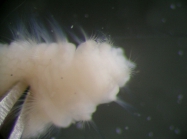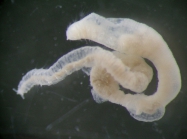WoRMS taxon details
Asclerocheilus Ashworth, 1901
129551 (urn:lsid:marinespecies.org:taxname:129551)
accepted
Genus
Lipobranchius intermedius Saint-Joseph, 1894 accepted as Asclerocheilus intermedius (Saint-Joseph, 1894) (type by monotypy)
Ascleriocheilus [auct.] · unaccepted (misspelling)
Gwasitoa Chamberlin, 1919 · unaccepted (subjective synonym)
Kebuita Chamberlin, 1919 · unaccepted > junior subjective synonym (subjective synonym)
- Species Asclerocheilus abyssalis Blake, 2023
- Species Asclerocheilus acirratus (Hartman, 1966)
- Species Asclerocheilus alaskaensis Blake, 2025
- Species Asclerocheilus alatus Blake, 2025
- Species Asclerocheilus ashworthi Blake, 1981
- Species Asclerocheilus aurospinosus Blake, 2025
- Species Asclerocheilus beringianus Uschakov, 1955
- Species Asclerocheilus blakei Mendes, Rodrigues & Rizzo, 2024
- Species Asclerocheilus brigitteae Blake, 2025
- Species Asclerocheilus californicus Hartman, 1963
- Species Asclerocheilus capensis Day, 1963
- Species Asclerocheilus caroliniensis Blake, 2025
- Species Asclerocheilus crenulatus Blake, 2025
- Species Asclerocheilus elisabethae Eibye-Jacobsen, 2002
- Species Asclerocheilus franciscanus Blake, 2025
- Species Asclerocheilus geiseae Mendes, De Paiva & Rizzo, 2024
- Species Asclerocheilus glabrus (Ehlers, 1887)
- Species Asclerocheilus heterochaetus Kudenov & Blake, 1978
- Species Asclerocheilus intermedius (Saint-Joseph, 1894)
- Species Asclerocheilus jonesi Blake, 2025
- Species Asclerocheilus kudenovi Blake, 2000
- Species Asclerocheilus magellaniensis Blake, 2025
- Species Asclerocheilus mexicanus Kudenov, 1985
- Species Asclerocheilus nathanae Blake, 2025
- Species Asclerocheilus neubertae Blake, 2025
- Species Asclerocheilus pseudocollare (Schüller & Hilbig, 2007)
- Species Asclerocheilus shanei Hartmann-Schröder, 1994
- Species Asclerocheilus shanonae Eibye-Jacobsen, 2002
- Species Asclerocheilus triangularis Blake, 2025
- Species Asclerocheilus tropicus Blake, 1981
- Species Asclerocheilus nigrocirrus Hartman, 1978 accepted as Oligobregma collare (Levenstein, 1975) (subjective synonym)
- Species Asclerocheilus tasmanius Kirkegaard, 1996 accepted as Oligobregma tasmania (Kirkegaard, 1996) (unaccepted > superseded combination, superseded original combination)
- Species Asclerocheilus victoriensis Blake, 2000 accepted as Asclerocheilus heterochaetus Kudenov & Blake, 1978 (unaccepted > junior objective synonym, superfluous replacement name for A. heterochaetus)
marine, brackish, fresh, terrestrial
recent only
masculine
Ashworth, James Hartley. 1901. The anatomy of <i>Scalibregma inflatum</i> Rathke. Quarterly Journal of Microscopical Science, London, 45: 237-309., available online at https://www.biodiversitylibrary.org/page/14709616
page(s): 297 [details]
page(s): 297 [details]
Etymology It is not clear from his text why Ashworth (1901) used Asclerocheilus. Grube's Sclerocheilus is a composition of the words...
Etymology It is not clear from his text why Ashworth (1901) used Asclerocheilus. Grube's Sclerocheilus is a composition of the words Sclero, 'hard', and Cheilus, 'lips' or 'rim'. Greek 'cheilos' is neuter, but Grube made a masculine noun compound word as Sclerocheilus. Addition of the Greek 'A' by Ashworth is a negative, thus meaning not with hard lips/rim, but his short diagnosis has nothing that fits that character state. [details]
Read, G.; Fauchald, K. (Ed.) (2025). World Polychaeta Database. Asclerocheilus Ashworth, 1901. Accessed through: World Register of Marine Species at: https://www.marinespecies.org/aphia.php?p=taxdetails&id=129551 on 2025-07-16
Date
action
by
![]() The webpage text is licensed under a Creative Commons
Attribution 4.0 License
The webpage text is licensed under a Creative Commons
Attribution 4.0 License
Nomenclature
original description
Ashworth, James Hartley. 1901. The anatomy of <i>Scalibregma inflatum</i> Rathke. Quarterly Journal of Microscopical Science, London, 45: 237-309., available online at https://www.biodiversitylibrary.org/page/14709616
page(s): 297 [details]
original description (of Kebuita Chamberlin, 1919) Chamberlin, Ralph V. (1919). The Annelida Polychaeta [Albatross Expeditions]. <em>Memoirs of the Museum of Comparative Zoology at Harvard College.</em> 48: 1-514., available online at http://www.biodiversitylibrary.org/ia/memoirsofmuseumo4801harv
page(s): 390, 391 [discussion]; note: erected for Eumenia glabra Ehleres, 1887, though a formal new combination was not published in the original publication [details]
original description (of Gwasitoa Chamberlin, 1919) Chamberlin, Ralph V. (1919). The Annelida Polychaeta [Albatross Expeditions]. <em>Memoirs of the Museum of Comparative Zoology at Harvard College.</em> 48: 1-514., available online at http://www.biodiversitylibrary.org/ia/memoirsofmuseumo4801harv
page(s): 390, 391 [discussion]; note: erected for Oncoscolex (Eumenia) heterochaetus Augener, 1906, though a formal new combination was not published [details]
page(s): 297 [details]
original description (of Kebuita Chamberlin, 1919) Chamberlin, Ralph V. (1919). The Annelida Polychaeta [Albatross Expeditions]. <em>Memoirs of the Museum of Comparative Zoology at Harvard College.</em> 48: 1-514., available online at http://www.biodiversitylibrary.org/ia/memoirsofmuseumo4801harv
page(s): 390, 391 [discussion]; note: erected for Eumenia glabra Ehleres, 1887, though a formal new combination was not published in the original publication [details]
original description (of Gwasitoa Chamberlin, 1919) Chamberlin, Ralph V. (1919). The Annelida Polychaeta [Albatross Expeditions]. <em>Memoirs of the Museum of Comparative Zoology at Harvard College.</em> 48: 1-514., available online at http://www.biodiversitylibrary.org/ia/memoirsofmuseumo4801harv
page(s): 390, 391 [discussion]; note: erected for Oncoscolex (Eumenia) heterochaetus Augener, 1906, though a formal new combination was not published [details]
Taxonomy
taxonomy source
Blake, James A. (2025). New species and records of Scalibregmatidae (Annelida) from the Atlantic Ocean, Indian Ocean, Pacific Ocean, Southern Ocean, and adjacent seas. <em>Megataxa.</em> 16(1): 1–232., available online at https://mapress.com/mt/article/view/megataxa.16.1.1
page(s): 6; note: Description of 12 new species and a tabulation of morphological characters of all 31 species [details]
page(s): 6; note: Description of 12 new species and a tabulation of morphological characters of all 31 species [details]
Identification resource
identification resource
Blake, James A. (2023). New species of Scalibregmatidae (Annelida) from slope and abyssal depths off eastern Australia. <em>Records of the Australian Museum.</em> 75(3): 271-298., available online at https://journals.australian.museum/blake-2023-rec-aust-mus-753-271298/
page(s): table 1; note: synoptic table comparing morphological characters of 15 known species of Asclerocheilus [details] Available for editors [request]
[request]
identification resource Mendes, Samuel Lucas Da Silva Delgado; De Paiva, Paulo Cesar; Rizzo, Alexandra E. (2024). On species of Asclerocheilus Ashworth, 1901 (Annelida: Scalibregmatidae) from Brazil. <em>European Journal of Taxonomy.</em> 947: 88-108., available online at https://europeanjournaloftaxonomy.eu/index.php/ejt/article/view/2621
page(s): 103; note: world key to genus [details] Available for editors [request]
[request]
page(s): table 1; note: synoptic table comparing morphological characters of 15 known species of Asclerocheilus [details] Available for editors
identification resource Mendes, Samuel Lucas Da Silva Delgado; De Paiva, Paulo Cesar; Rizzo, Alexandra E. (2024). On species of Asclerocheilus Ashworth, 1901 (Annelida: Scalibregmatidae) from Brazil. <em>European Journal of Taxonomy.</em> 947: 88-108., available online at https://europeanjournaloftaxonomy.eu/index.php/ejt/article/view/2621
page(s): 103; note: world key to genus [details] Available for editors
Other
additional source
Fauchald, K. (1977). The polychaete worms, definitions and keys to the orders, families and genera. <em>Natural History Museum of Los Angeles County: Los Angeles, CA (USA), Science Series.</em> 28:1-188., available online at http://www.vliz.be/imisdocs/publications/123110.pdf [details]
additional source Bellan, G. (2001). Polychaeta, <i>in</i>: Costello, M.J. <i>et al.</i> (Ed.) (2001). European register of marine species: a check-list of the marine species in Europe and a bibliography of guides to their identification. <em>Collection Patrimoines Naturels.</em> 50: 214-231. (look up in IMIS) [details]
additional source Bellan, G. (2001). Polychaeta, <i>in</i>: Costello, M.J. <i>et al.</i> (Ed.) (2001). European register of marine species: a check-list of the marine species in Europe and a bibliography of guides to their identification. <em>Collection Patrimoines Naturels.</em> 50: 214-231. (look up in IMIS) [details]
 Present
Present  Inaccurate
Inaccurate  Introduced: alien
Introduced: alien  Containing type locality
Containing type locality
From editor or global species database
Diagnosis [Diagnosis of Blake, 2025] Body elongate, arenicoliform. Prostomium with a pair or lateral or frontal horns. Parapodia of posterior segments reduced; dorsal and ventral cirri absent; interramal papillae or lobe present or absent; postchaetal lamellae absent. Branchiae absent. chaetae include capillaries, furcate chaetae, and large, conspicuous curved spines on setigers 1, 1–2, 1–3, or 1–4, sometimes accompanied by short spinous chaetae anterior to spines. Pygidium with long anal cirri. [details]Etymology It is not clear from his text why Ashworth (1901) used Asclerocheilus. Grube's Sclerocheilus is a composition of the words Sclero, 'hard', and Cheilus, 'lips' or 'rim'. Greek 'cheilos' is neuter, but Grube made a masculine noun compound word as Sclerocheilus. Addition of the Greek 'A' by Ashworth is a negative, thus meaning not with hard lips/rim, but his short diagnosis has nothing that fits that character state. [details]
Grammatical gender Masculine. Although 'sclerocheilus' could be neuter, Grube's Sclerocheilus usages are as masculine and thus so are Asclerocheilus usages. All adjectival Asclerocheilus species names have used masculine suffices. Elsewhere '-cheilus' names in WoRMS have been treated as masculine. [details]


